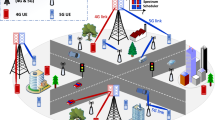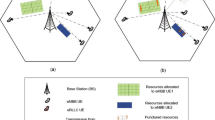Abstract
Deploying low-power nodes (LPNs) overlaid with Macro cells is a promising strategy to improve the coverage and capacity of cellular systems. Meanwhile, cell range expansion (CRE) scheme is proposed to select a proper serving base station (BS) for users between Macro eNodeBs and LPNs, and then offloading of traffic from Macro cell is made. In this paper, first, we introduce the LPNs deployment strategy and its activation criteria in the heterogeneous system. Then, a quality of experience (QoE)-based CRE scheme to adjust the coverage area of LPNs adaptively is proposed. Different from the existing CRE schemes, the QoE values for different users with different services are considered when the users try to select an appropriate serving BS. Finally, simulation results demonstrate that the proposed scheme can improve cell edge user experience for various services as well as overall system performance.
创新点
本文主要研究了LTE-Advanced系统异构网络中低功率节点的部署问题以及部署完成后小区选择算法的设计。小区范围扩展(CRE)方案提出的目的是将部分用户接入到邻近的低功率节点所在的小区, 从而降低宏小区的负载量。本文首先介绍了异构网络中低功率节点的部署和激活准则, 然后提出了一种基于用户体验质量的自适应CRE算法。该算法综合考虑了不同业务下的用户对功率以及用户体验质量的不同需求, 从用户需求角度出发, 设计了一种新的小区范围扩展算法。最后, 仿真结果验证了所提算法在用户体验质量和系统吞吐量两方面的性能要求, 说明了所提算法的可行性和有效性。
Similar content being viewed by others
References
3GPP. TS 36.211 Evolved Universal Terrestrial Radio Access (EUTRA): Physical Channel and Modulation, Release 8
Xu X D, Wang D, Tao X F, et al. Resource pooling for frameless network architecture with adaptive resource allocation. Sci China Inf Sci, 2013, 56: 152–163
Ding H C, Yang G H, Ma S D, et al. Performance analysis for heterogeneous cellular systems with range expansion. In: Proceedings of Vehicular Technology Conference (VTC Fall), Las Vegas, 2013. 1–5
Luo D, Li B, Yang D C. Performance evaluation with range expansion for heterogeneous networks. In: Proceedings of Vehicular Technology Conference (VTC Fall), San Francisco, 2011. 1–5
Fei Z S, Ding H C, Xing C W, et al. Performance analysis for range expansion in heterogeneous networks. SCI China Inf Sci, 2014, 57: 082305
Ronald Y C, Tao Z F, Zhang J Y, et al. A graph approach to dynamic fractional frequency reuse (FFR) in multi-cell OFDMA networks. In: Proceedings of IEEE International Conference on Communications, Dresden, 2009. 1–6
Kenta O, Taku N, Chiharu Y, et al. Pico cell range expansion with interference mitigation toward LTE-advanced heterogeneous networks. In: Proceedings of IEEE International Conference on Communications, Kyoto, 2011. 1–5
Aleksandar D, Juan M, Yongbin W, et al. A survey on 3GPP heterogeneous networks. IEEE Wirel Commun, 2011, 18: 10–21
3GPP. TSG-RAN WG1 Meeting #58 bias R1-0.094225. DL Performance with Hotzone Cells. Qualcomm Europe, Miyazaki, 2009
3GPP. TSG-RAN WG1 Meeting #62. Way Forward on eICIC for non-CA based HetNets. 2010.
Cao Y, Xia HL, Feng C Y. Evaluation of diverse cell range expansion strategies applying CoMP in heteregeneous network. In: Proceedings of IEEE 24th International Symposium on Personal Indoor and Mobile Radio Communications (PIMRC), London, 2013. 1962–1966
ITU-T P.10/G.100. Vocabulary and Effects of Transmission Parameters on Customer Opinion of Transmission Quality. 2008
Gu X Y, Li W Y, Zhang L. Adaptive cell range control in heterogeneous network. In: Proceedings of International Conference on Wireless Communications & Signal Processing (WCSP), Hangzhou, 2013. 1–5
Tian P, Tian H, Zhu J C, et al. An adaptive bias configuration strategy for range extension in LTE-advanced heterogeneous networks. In: Proceedings of IET International Conference on Communication Technology and Application (ICCTA 2011), Beijing, 2011. 336–340
Wang J, Liu J G, Wang D Y, et al. Optimized fairness cell selection for 3GPP LTE-A macro-pico HetNets. In: Proceedings of Vehicular Technology Conference (VTC Fall), San Francisco, 2011. 1–5
Guvenc I, Jeong M R, Demirdogen I, et al. Range expansion and inter-cell interference coordination (ICIC) for picocell networks. In: Proceedings of Vehicular Technology Conference (VTC Fall), San Francisco, 2011. 1–5
Yasir B A, Su G, Bachache N. Range expansion for pico cell in heterogeneous LTE-a cellular networks. In: Proceedings of 2nd International Conference on Computer Science and Network Technology (ICCSNT), Changchun, 2012. 1235–1240
Quan W, Guan J, Xu C, et al. G-MER: green mobility estimation-based routing protocol in wireless sensor networks. China Commun, 2012, 9: 10–21
Zhang Z S, Long K P, Wang J P. Self-organization paradigms and optimization approaches for cognitive radio technologies: a survey. IEEE Wirel Commun, 2013. 20: 36–42
Zhang Z S, Long K P, Wang J P, et al. On swarm intelligence inspired self-organized networking: its bionic mechanisms, designing principles and optimization approaches. IEEE Commun Surv Tutor, 2014, 16: 513–537
Xu F. Fractional frequency reuse (FFR) and FFR-based scheduling in OFDMA systems. In: Proceedings of 2010 International Conference on Multimedia Technology (ICMT), Ningbo, 2010. 1–4
Madhavan V, Aleksandar D, Juan M, et al. Downlink FTP performance of heterogeneous networks for LTE-advanced. In: Proceedings of IEEE International Conference on Communications Workshops, Kyoto, 2011. 1–5
Sara L, Hideshi M, Arne S. Deployment aspect of LTE pico nodes. In: Proceedings of IEEE International Conference on Communications Workshops (ICC), Kyoto, 2011. 1–5
Stanislaw S, Klaus I P, Jaroslaw L, et al. Performance optimization of pico node deployment in LTE macro cells. In: Proceedings of Future Network & Mobile Summit (Future Netw), Warsaw, 2011. 1–9
Huangfu W, Zhang Z S, Chai X M, et al. Survivability-oriented optimal node density for randomly deployed wireless sensor networks. SCI China Inf Sci, 2014. 57: 029301
Fei Z S, Xing C W, Li N. QoE-driven resource allocation for mobile IP services in wireless network. SCI China Inf Sci, 2014, 57: 012301
ITU P.862. Perceptual evaluation of speech quality (PESQ): an objective method for end-to-end speech quality assessment of narrow-band telephone networks and speech codecs. 2001
Srisakua T, Shoaib K, Eckehard S, et al. QoE-driven cross-layer optimization for high speed downlink packet access. J Commun, 2009, 4: 669–680
Asiya K, Sun L F, Ifeachor E. Content clustering based video quality prediction model for MPEG4 video streaming over wireless networks. In: Proceedings of IEEE International Conference on Communications, Dresden, 2009. 1–5
Kelly F. Charging and rate control for elastic traffic. Eur Trans Telecommun, 1997, 8: 33–37
Zhao J H, Chen X M, Luo J Y, et al. An improved resource allocation method based on convex optimization in centralized wireless network. In: Proceedings of 5th International Conference on Wireless Communications, Beijing, 2009. 1–4
Sun H, Wang D M, Meng S, et al. Power allocation algorithm in amplify and forward relay networks. In: Proceedings of 4th International Conference on Wireless Communications, Dalian, 2008. 1–4
3GPP. TR 36.814. Further advancements for E-UTRA physical layer aspects, v9.0.0, 2010
Author information
Authors and Affiliations
Corresponding author
Rights and permissions
About this article
Cite this article
Yuan, T., Fei, Z., Li, N. et al. A QoE-based cell range expansion scheme in heterogeneous cellular networks. Sci. China Inf. Sci. 58, 1–11 (2015). https://doi.org/10.1007/s11432-015-5297-7
Received:
Accepted:
Published:
Issue Date:
DOI: https://doi.org/10.1007/s11432-015-5297-7




